Zongyuan Yang
DirectL: Efficient Radiance Fields Rendering for 3D Light Field Displays
Jul 19, 2024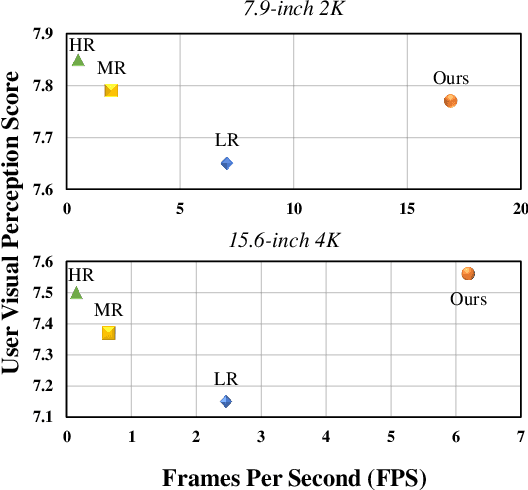
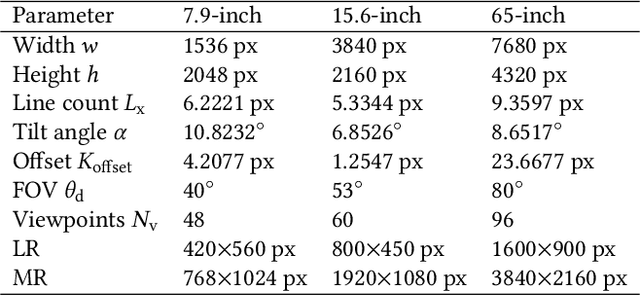
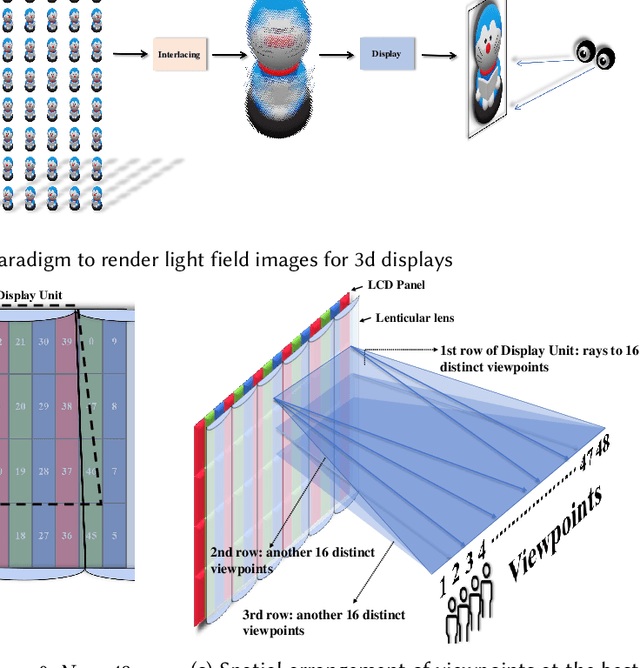

Abstract:Autostereoscopic display, despite decades of development, has not achieved extensive application, primarily due to the daunting challenge of 3D content creation for non-specialists. The emergence of Radiance Field as an innovative 3D representation has markedly revolutionized the domains of 3D reconstruction and generation. This technology greatly simplifies 3D content creation for common users, broadening the applicability of Light Field Displays (LFDs). However, the combination of these two fields remains largely unexplored. The standard paradigm to create optimal content for parallax-based light field displays demands rendering at least 45 slightly shifted views preferably at high resolution per frame, a substantial hurdle for real-time rendering. We introduce DirectL, a novel rendering paradigm for Radiance Fields on 3D displays. We thoroughly analyze the interweaved mapping of spatial rays to screen subpixels, precisely determine the light rays entering the human eye, and propose subpixel repurposing to significantly reduce the pixel count required for rendering. Tailored for the two predominant radiance fields--Neural Radiance Fields (NeRFs) and 3D Gaussian Splatting (3DGS), we propose corresponding optimized rendering pipelines that directly render the light field images instead of multi-view images. Extensive experiments across various displays and user study demonstrate that DirectL accelerates rendering by up to 40 times compared to the standard paradigm without sacrificing visual quality. Its rendering process-only modification allows seamless integration into subsequent radiance field tasks. Finally, we integrate DirectL into diverse applications, showcasing the stunning visual experiences and the synergy between LFDs and Radiance Fields, which unveils tremendous potential for commercialization applications. \href{direct-l.github.io}{\textbf{Project Homepage}
TextDiff: Mask-Guided Residual Diffusion Models for Scene Text Image Super-Resolution
Aug 13, 2023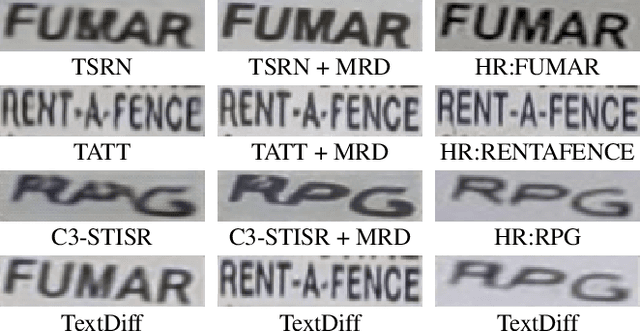



Abstract:The goal of scene text image super-resolution is to reconstruct high-resolution text-line images from unrecognizable low-resolution inputs. The existing methods relying on the optimization of pixel-level loss tend to yield text edges that exhibit a notable degree of blurring, thereby exerting a substantial impact on both the readability and recognizability of the text. To address these issues, we propose TextDiff, the first diffusion-based framework tailored for scene text image super-resolution. It contains two modules: the Text Enhancement Module (TEM) and the Mask-Guided Residual Diffusion Module (MRD). The TEM generates an initial deblurred text image and a mask that encodes the spatial location of the text. The MRD is responsible for effectively sharpening the text edge by modeling the residuals between the ground-truth images and the initial deblurred images. Extensive experiments demonstrate that our TextDiff achieves state-of-the-art (SOTA) performance on public benchmark datasets and can improve the readability of scene text images. Moreover, our proposed MRD module is plug-and-play that effectively sharpens the text edges produced by SOTA methods. This enhancement not only improves the readability and recognizability of the results generated by SOTA methods but also does not require any additional joint training. Available Codes:https://github.com/Lenubolim/TextDiff.
DDG-Net: Discriminability-Driven Graph Network for Weakly-supervised Temporal Action Localization
Aug 07, 2023



Abstract:Weakly-supervised temporal action localization (WTAL) is a practical yet challenging task. Due to large-scale datasets, most existing methods use a network pretrained in other datasets to extract features, which are not suitable enough for WTAL. To address this problem, researchers design several modules for feature enhancement, which improve the performance of the localization module, especially modeling the temporal relationship between snippets. However, all of them neglect the adverse effects of ambiguous information, which would reduce the discriminability of others. Considering this phenomenon, we propose Discriminability-Driven Graph Network (DDG-Net), which explicitly models ambiguous snippets and discriminative snippets with well-designed connections, preventing the transmission of ambiguous information and enhancing the discriminability of snippet-level representations. Additionally, we propose feature consistency loss to prevent the assimilation of features and drive the graph convolution network to generate more discriminative representations. Extensive experiments on THUMOS14 and ActivityNet1.2 benchmarks demonstrate the effectiveness of DDG-Net, establishing new state-of-the-art results on both datasets. Source code is available at \url{https://github.com/XiaojunTang22/ICCV2023-DDGNet}.
DocDiff: Document Enhancement via Residual Diffusion Models
May 06, 2023Abstract:Removing degradation from document images not only improves their visual quality and readability, but also enhances the performance of numerous automated document analysis and recognition tasks. However, existing regression-based methods optimized for pixel-level distortion reduction tend to suffer from significant loss of high-frequency information, leading to distorted and blurred text edges. To compensate for this major deficiency, we propose DocDiff, the first diffusion-based framework specifically designed for diverse challenging document enhancement problems, including document deblurring, denoising, and removal of watermarks and seals. DocDiff consists of two modules: the Coarse Predictor (CP), which is responsible for recovering the primary low-frequency content, and the High-Frequency Residual Refinement (HRR) module, which adopts the diffusion models to predict the residual (high-frequency information, including text edges), between the ground-truth and the CP-predicted image. DocDiff is a compact and computationally efficient model that benefits from a well-designed network architecture, an optimized training loss objective, and a deterministic sampling process with short time steps. Extensive experiments demonstrate that DocDiff achieves state-of-the-art (SOTA) performance on multiple benchmark datasets, and can significantly enhance the readability and recognizability of degraded document images. Furthermore, our proposed HRR module in pre-trained DocDiff is plug-and-play and ready-to-use, with only 4.17M parameters. It greatly sharpens the text edges generated by SOTA deblurring methods without additional joint training. Available codes: https://github.com/Royalvice/DocDiff
GDB: Gated convolutions-based Document Binarization
Feb 04, 2023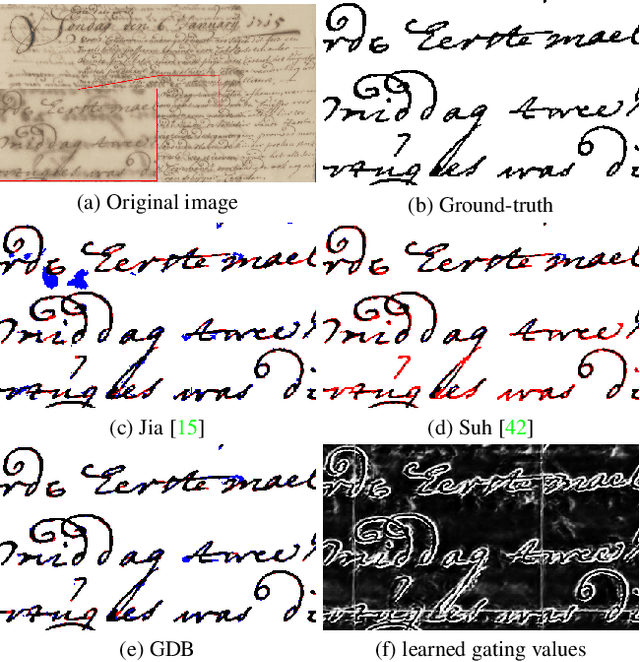
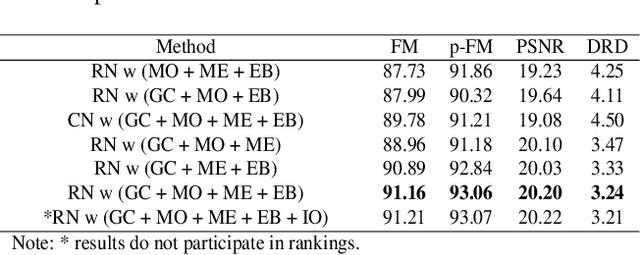
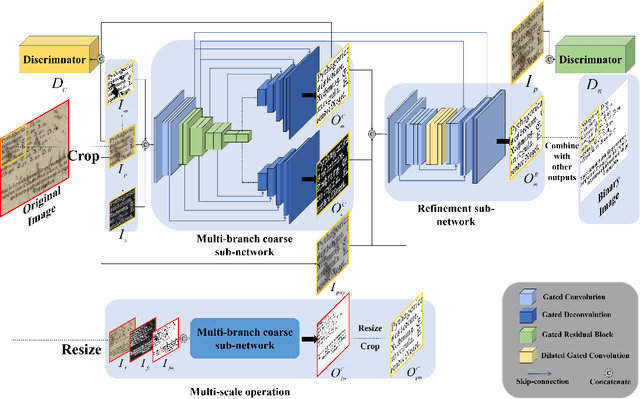
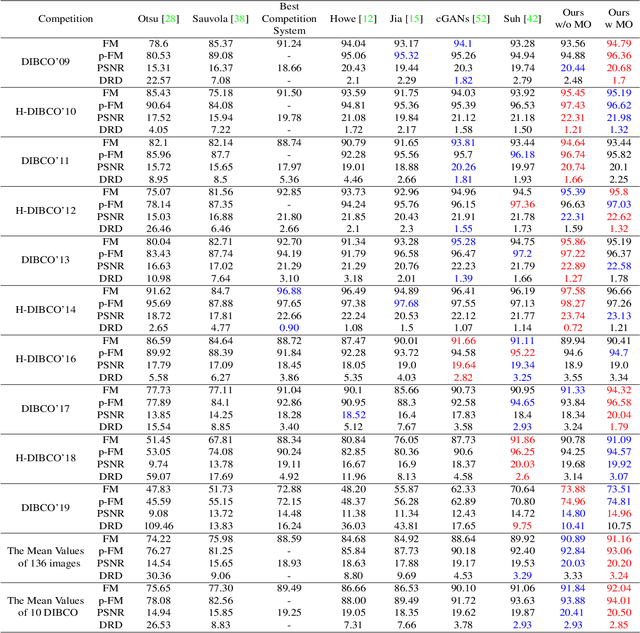
Abstract:Document binarization is a key pre-processing step for many document analysis tasks. However, existing methods can not extract stroke edges finely, mainly due to the fair-treatment nature of vanilla convolutions and the extraction of stroke edges without adequate supervision by boundary-related information. In this paper, we formulate text extraction as the learning of gating values and propose an end-to-end gated convolutions-based network (GDB) to solve the problem of imprecise stroke edge extraction. The gated convolutions are applied to selectively extract the features of strokes with different attention. Our proposed framework consists of two stages. Firstly, a coarse sub-network with an extra edge branch is trained to get more precise feature maps by feeding a priori mask and edge. Secondly, a refinement sub-network is cascaded to refine the output of the first stage by gated convolutions based on the sharp edge. For global information, GDB also contains a multi-scale operation to combine local and global features. We conduct comprehensive experiments on ten Document Image Binarization Contest (DIBCO) datasets from 2009 to 2019. Experimental results show that our proposed methods outperform the state-of-the-art methods in terms of all metrics on average and achieve top ranking on six benchmark datasets.
 Add to Chrome
Add to Chrome Add to Firefox
Add to Firefox Add to Edge
Add to Edge